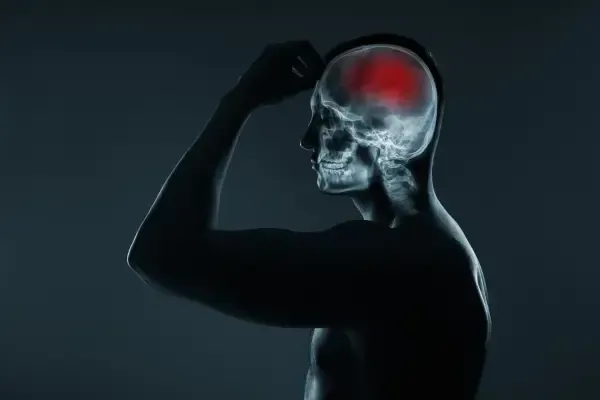
Recovering from Strokes
Did you know that Strokes are one of the leading causes of death and disability in the world?
In fact, about 17,000,000 people around the world suffer from a significant stroke every year! And about 5,000,000 experience long-term disability.
What is a Stroke?
A stroke is something that causes a problem with the blood supply to the brain. This could be a blockage in an artery in the brain or a bleed in the brain itself. Without blood, the brain doesn’t work, which is why strokes can be fatal or result in significant long-term disability. One of the most common disabilities after a stroke is muscle weakness. This may mean that after a stroke, a person has trouble using their arm or hand, or they may struggle to stand or walk.

What does the research show?
Over the past 20 years, scientists have been showing that chiropractic care can actually change the way your brain works and how it controls your body, including movement and strength.7-16
A number of recent studies have shown that a single session of chiropractic care can result in an immediate increase in strength. In one of these studies, the researchers found a 16% increase in strength of leg muscles in a group of students after a session of chiropractic care.
Another study reported 8% increase in strength in elite athletes after they were adjusted by a chiropractor,19 and one more study found an 11% increase in jaw strength in a group of healthy people after chiropractic adjustments.
But could chiropractic care help someone who has muscle weakness because they’ve had a stroke?
A new study says maybe it can! In this study, researchers looked at changes in strength in weak leg muscles after chiropractic care in people who had suffered from a stroke.
The team of scientists that did this study measured the strength of weak leg muscles in chronic stroke patients before and after a single session of chiropractic care or a sham control session.
They also used electrical stimulations of nerves in their legs, which could help them to work out whether any changes in strength came from their brain or something that was happening in their spinal cord. When they analysed the data from their study, the scientists found an average improvement in strength of almost 65% in the affected leg of these stroke patients.
They also found that these strength changes were due to changes in the way their brain was communicating with these weak muscles, as opposed to changes in their spinal cord.
These results are really exciting, but you do need to remember that the scientists only looked at immediate changes after chiropractic care, so they don’t yet know how long the changes last for. These initial ground-breaking findings are really important and may mean that chiropractic care can help people who have had a stroke to improve their strength and ability to walk and move.
So, if someone you know has suffered from a stroke, let them know that chiropractic care may really help to improve their brain/body communication and to get them moving and living life again to the fullest!
Disclaimer and References This information is provided for educational purposes only. It is not intended to be professional advice of any kind. Haavik Research Ltd encourages you to make your own health care decisions based on your own research and in partnership with a qualified health care professional. chiroshub.com © Haavik Research 2021 1. Sherzai AZ, Elkind MS. Ann N Y Acad Sci 2015;1338:1-15. 2. Clarke DJ, Forster A. J Multidiscip Healthc 2015;8:433-42. 3. Chen JC, Shaw FZ. World J Clin Cases 2014;2(8):316-26. 4. Veerbeek JM, Langbroek-Amersfoort AC, van Wegen EE, et al. 2017;31(2):107-21. 5. Greisberger A, Aviv H, Garbade SF, et al. J Rehabil Med 2016;48(5):405-16. 6. Wist S, Clivaz J, Sattelmayer M. 2016;59(2):114-24. 7. Haavik H, Murphy B.2011;34:88-97. 8. Haavik H, Murphy B. 2012;22(5):768-76. 9. Haavik Taylor H, Murphy B. Exp 2007;178(4):488-98. 10. Haavik Taylor H, Murphy B. Clin Neurophysiol 2007;118(2):391-402. 11. Haavik Taylor H, Murphy B. 2007;37:106-16. 12. Haavik Taylor H, Murphy B. 2008;31(2):115-26. 13. Haavik Taylor H, Murphy B. 2010;33 (3):178-88. 14. Haavik Taylor H, Murphy B. 2010;33 (4):261-72. 15. Marshall P, Murphy B. 2006;29(3 ):196-202. 16. Niazi I, Türker K, Flavel S, et al. Exp Brain Res 2015;233:1165-73. 17. Niazi IK, Turker KS, Flavel S, et al. 2015. 18. Haavik H, Ozyurt MG, Niazi IK, et al. 2018;8(5). 19. Christiansen TL, Niazi IK, Holt K, et al. 2018;118(4):737-49. 20. Holt K, Niazi IK, Nedergaard RW, et al. 2019;9(1):2673.
Dr. Heidi Haavik BSc(Physiol) BSc(Chiro) PhD • Dr. Kelly Holt BSc, BSc(Chiro), PGDipHSc, PhD • Dr. Jenna Duehr BChiro, BHSc(Nursing), MHSc
